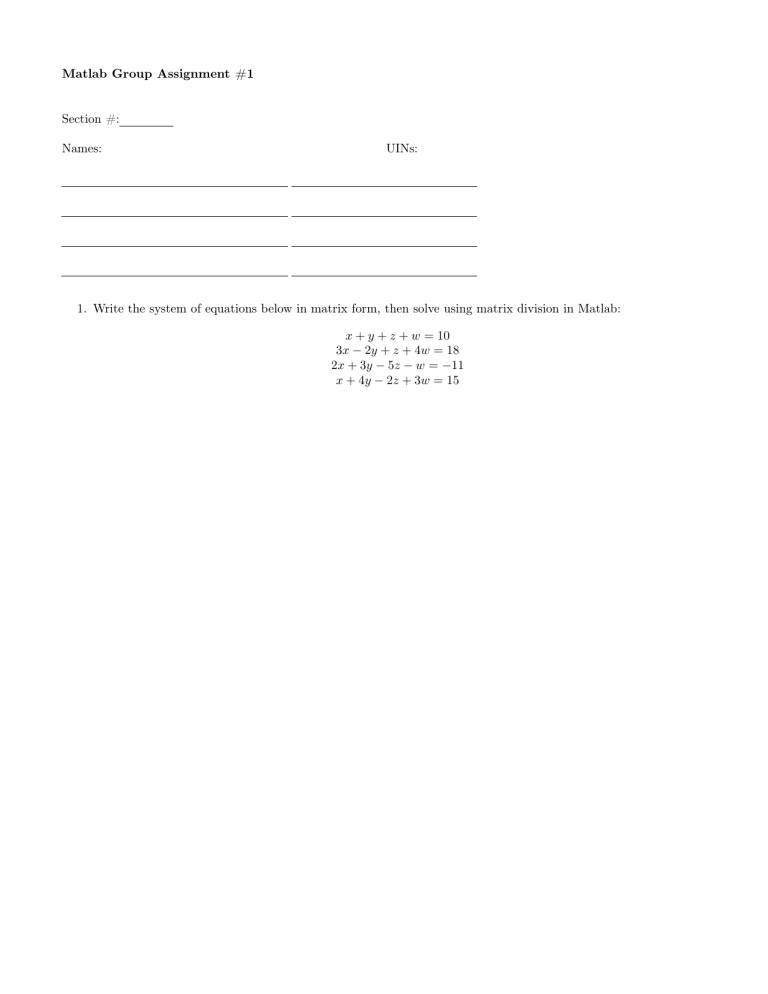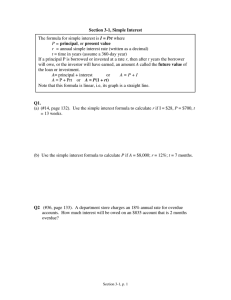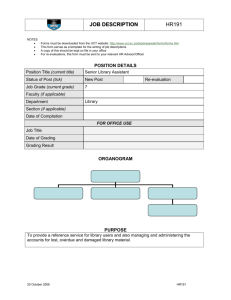Matlab Group Assignment #1 Section #: Names: UINs:

Matlab Group Assignment #1
Section #:
Names: UINs:
1. Write the system of equations below in matrix form, then solve using matrix division in Matlab: x + y + z + w = 10
3 x − 2 y + z + 4 w = 18
2 x + 3 y − 5 z − w = − 11 x + 4 y − 2 z + 3 w = 15
2. Repeat for the following system of equations. In the space below, explain Matlab’s warning and what is actually happening (if you are not sure, try using the solve command as well).
x + y + z = 1 x + z = 1
2 x + y + 2 z = 0
3. Repeat for the following system of equations. In the space below, explain Matlab’s warning and what is actually happening.
x + y + z = 3
2 y + z = 4 x − y = − 1
For the remainder of this lab, we will be applying matrices and systems of equations to Engineering applications.
CHOOSE ONE OF THE FOLLOWING APPLICATIONS TO SOLVE.
Use the principles stated to set up a system of equations and solve in Matlab.
Truss Problem (for MEEN, CVEN, AERO, PETE majors especially)
Basis for this type of problem: Newton’s Law
X
F x
= 0 ,
X
F y
= 0
The truss below was built to support an escalator with the loads shown. Horizontal bars are 1m long; vertical bars are 1.3m long. Find the force in each bar of the truss, and the reaction forces at points A and E . (NOTE: there is no vertical reaction force at E , only horizontal. There is a horizontal and vertical reaction force at A .)
(HINT: For an example of how to set up the equations, see Gilat, p130 #22-23)
900 lb
E
1800 lb
C
D
900 lb
A
B
Resistive Circuit Problem (for ECEN, CPSC majors especially)
Basis for this type of problem: Kirchhoff’s Law
X
V = 0 , V = IR
The electrical circuit shown consists of resistors and voltage sources. Determine the current in each resistor.
(HINT: The mesh current method is illustrated in Gilat p83)
V
1
R
1
= 38 V, V
2
= 15Ω , R
2
= 20 V, V
3
= 18Ω , R
= 24
3
V
= 10Ω , R
4
= 9Ω , R
5
= 5Ω , R
6
= 14Ω , R
7
= 8Ω , R
8
= 13Ω
( Problem choices continue on next page)
Mass-Balance Reactor Problem (for CHEN, BIEN, BICH majors especially)
Basis for this type of problem: Given a conservative material passing through a solution in a reactor,
X input =
X output and m = Qc (mass = flow rate times concentration). For further explanation, see http://www.math.tamu.edu/~dmanuel/math151/ChemReactorFlow.pdf.
The reactor below consists of 8 interconnected reactors. The flow rate (in m
3 / min) and concentrations (in g/ m
3
) are given below. Find the concentration of solutions in each of the reactors.
Q c
1
Q =9
12 c
2
Q =2
22
Q =2
23 c
3
Q =6
14
Q =3
51
Q =5
25
Q =8
06 c =50
06 c
6 c
4
Q =11
46
Q =5
34
Q =19
67 c
7
Q =9
78
Q =10
77 c
5
Q =3
53
Q =8
55 c
8
Q =9
85
Steady-State Markov Processes (for INEN and non-engineering majors especially)
Basis for this type of problem: if M is a probability matrix, the steady-state value of X is found by solving ( M − I ) X = 0 along with sum ( X ) = 1 . See www.math.tamu.edu/~dmanuel/math151/Markov.pdf for more details.
The credit department of Wal-Markov has analyzed repayment habits of their charge account customers. Customers are labeled “Paid”, “Overdue 1 month”, “Overdue 2 months”, etc., up to 6 months, after which time their account is written off as “Unpayable”. Customers can lower their overdue number by paying back a portion of their charge account. (See http://www.crc.man.ed.ac.uk/conference/archive/2011/Kellett-Dan-Presentation-UK-Credit-Card-Loss-Forecasting-Using-
Markov-Chain-Models.pdf for a practical example)
A summary of the data is given below.
• 70% of paid accounts remain paid the next month.
• 60% of accounts one month overdue are paid the next month; 25% remain one month overdue
• 50% of accounts two months overdue are paid the next month; 20% reduce to one month overdue; 10% remain two months overdue
• 40% of accounts three months overdue are paid the next month; 15% reduce to one month overdue; 5% reduce to two months overdue; 23% remain 3 months overdue
• 30% of accounts four months overdue are paid the next month; 10% reduce to one month overdue; 10% reduce to three months overdue; 32% remain four months overdue
• 20% of accounts five months overdue are paid the next month; 5% reduce to one month overdue; 5% reduce to three months overdue; 15% reduce to four months overdue; 35% remain five months overdue
• 10% of accounts six months overdue are paid the next month; 14% reduce to four months overdue; 14% reduce to five months overdue; 37% remain six months overdue
• 10% of unpayable accounts are able to reduce to six months overdue
Find the probability matrix M and determine the steady-state. What percentage of accounts will end up unpayable in the long term?




